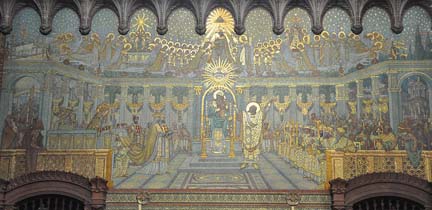Note: this post is part 3 of a series. We suggest you read pats one and two first.
By Robert Petrovich
Every one, of whatsoever city it may be, who has suffered therein on my account, would not be giving light, even as the sun, if I had looked towards my accusers and not towards God and if also I had not been deemed worthy to be given a share in those things . . . brought to pass by God; for this affair is not mine but Christ’s who made me mighty.
– from The Bazaar of Heracleides
The Council of Ephesus (A.D. 431)
Soon after Pentecost, the bishops and imperial officials assemble at Ephesus. Only the famous Augustine of Hippo and the other bishops of North Africa are indisposed to attend, owing to the Vandal invasions of their territories. John of Antioch, held back by circumstances surrounding a drought in his territories, sends the message that he hopes to arrive in several days and not to wait for him to convene the council. Cyril and his followers, with the support of the Bishop of Ephesus and the populace of Ephesus, assemble in the Church of the Theotokos. Nestorius is summoned but refuses to attend until all the bishops are assembled. With the Gospels placed on the throne to represent the presence of Christ, Cyril proceeds to open the first session without delay. Creeds and letters are read at the first session. Cyril’s letters are received with acclamation, those of Nestorius with anathemas. The council deposes and excommunicates Nestorius. When John of Antioch and the bishops of the East arrive four days later, they immediately hold council to depose Cyril and excommunicate all those who will not repudiate Cyril’s twelve anathemas. Three days later, an imperial rescript arrives that rebukes Cyril for his haste and commands all the bishops to await the arrival of an imperial commissioner. Cyril continues the council anyway. Rome’s legates arrive and give their support to Cyril at a second session. During the fourth session, John sends the message that he refuses to have anything more to do with Cyril and his supporters.

Representation of the Counceil of Ephesus 431, at the center Cyril of Alexandria shows the image of the infant and Mary, proclaiming her divine maternity. Image from the Church Notre-Dame de Fourvieres, Lyon, France
In August, the imperial commissioner arrives. He deposes and arrests Nestorius, Cyril, and the Bishop of Ephesus; he also tries to persuade the Cyrillians to confer with the bishops of the East, who have drawn up a formulary of reunion, but the Cyrillians refuse and continue to stir up the clergy of Constantinople with their appeals. On September 11, the emperor receives seven delegates from each side at Chalcedon, but no agreement is reached. The emperor dissolves the council, sends Nestorius back to his former monastery at Antioch, per his request, and orders the consecration of a new Bishop of Constantinople, who proceeds to depose those bishops who continue to adhere to Nestorius. After the rival parties go home, Cyril is released from prison and, in October, arrives at Alexandria in triumph.
Rome, in exchange for the vote to depose Nestorius, gets Pelagius condemned by an ecumenical council and wins greater prestige in the East because Cyril, going over the head of the emperor, had appealed to the Bishop of Rome; in exchange for the vote to condemn Pelagius, the Alexandrians get Nestorius deposed, as well as Cyril’s explanation of the incarnation canonized over the doctrine of Nestorius.
The Reconciled and the Irreconcilable
In spring 432, the emperor suggests as a basis of reconciliation that the East give up Nestorius and that Cyril give up his twelve anathemas. By autumn, John of Antioch and a few others go ahead with the reconciliation; some waver; and others, like the Bishop of Hierapolis in Syria, stand out. Those for reconciliation send to Alexandria an envoy who brings the Formulary of Reunion and other propositions; when the envoy arrives, John is pressed to accept the deposition of Nestorius, whereupon he is received into communion at Alexandria and admitted to preach there on Christmas Day as an orthodox bishop. In 433 John and Cyril sign the Formula of Reunion, and it is ratified by the emperor. After this action is taken, whoever wishes to be part of the catholic and orthodox Imperial Church must, in their thought and speech, avoid denying the humanity of the rational soul of Christ and at the same time avoid dividing his two natures into two persons. Some bishops of the East acknowledge the orthodoxy of Cyril but refuse to accept the deposition of Nestorius; others denounce both. The following year, Proclus, the old adversary of Nestorius, is consecrated Bishop of Constantinople, and the emperor orders all bishops of the East to abandon their resistance to John and Cyril. Many obey, but eighteen are deposed; they are banished to the mines of the Egyptian Thebaid, as persecuted Christians in the Roman Empire had been since Diocletian.
This article was previously published in the Community Communique for the Cosolargy community.
